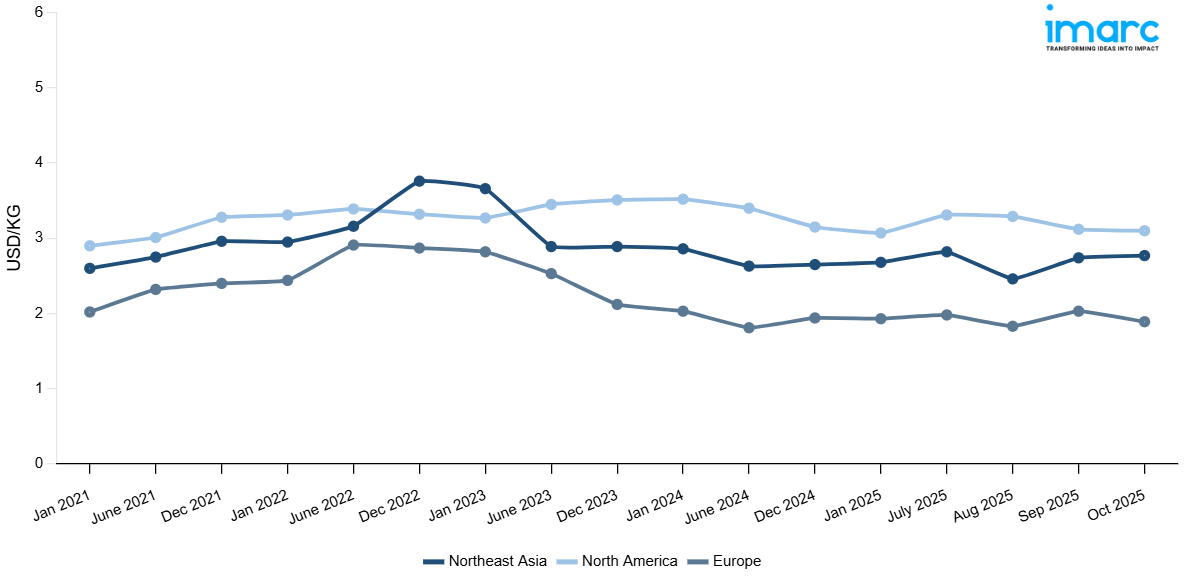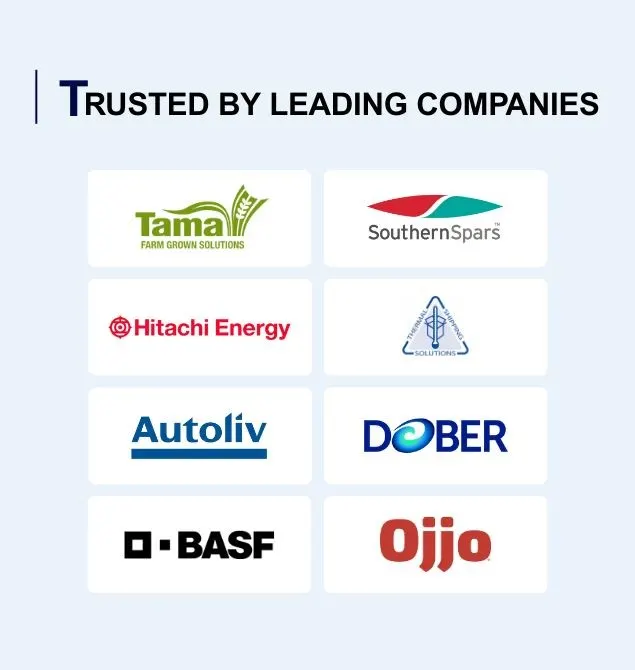
Isoprene Rubber Prices, Trend, Chart, Demand, Market Analysis, News, Historical and Forecast Data Report 2025 Edition
Isoprene Rubber Price Trend, Index and Forecast
Track real-time and historical isoprene rubber prices across global regions. Updated monthly with market insights, drivers, and forecasts.
Isoprene Rubber Prices October 2025
| Region | Price (USD/Kg) | Latest Movement |
|---|---|---|
| Northeast Asia | 2.77 | 1.0% ↑ Up |
| Europe | 1.89 | -6.9% ↓ Down |
| North America | 3.10 | -0.7% ↓ Down |
Isoprene Rubber Price Index (USD/KG):
The chart below highlights monthly isoprene rubber prices across different regions.

Get Access to Monthly/Quaterly/Yearly Prices, Request Sample
Market Overview Q3 Ending September 2025
Northeast Asia: The upward movement was driven primarily by strong demand from the automotive and tire manufacturing sectors, where production schedules increased post-mid-year inventory replenishments. Supply-side constraints included limited domestic production in South Korea and Japan, coupled with delays in imports from Southeast Asia due to port congestion and shipping logistics. Cost components such as international freight, customs clearance, and regional currency fluctuations also contributed to higher landed costs. Energy price volatility in the region, particularly electricity and natural gas used in polymerization, marginally elevated production costs.
Europe: The market benefited from strong downstream demand in tire production, industrial belts, and adhesives, driven by seasonal manufacturing cycles. Supply-side factors included production limitations in Germany, France, and Italy, with some supply gaps due to scheduled maintenance in key polymerization facilities. Energy and raw material costs, particularly monomer isoprene feedstock, increased moderately, supporting higher domestic prices. Additionally, stringent EU environmental and safety regulations continued to impose operational constraints, indirectly affecting overall pricing. The combination of heightened demand, constrained supply, and incremental production costs led to the notable price rise.
North America: The decrease was primarily influenced by reduced tire and automotive production activity, following slower-than-expected industrial output in the United States and Canada. Domestic production remained stable, but inventories in major storage hubs increased, leading to temporary oversupply in regional markets. Key cost factors, including energy, logistics, and port handling, were largely unchanged; however, favorable US Dollar strength against other currencies contributed to lower import-adjusted costs. Compliance with environmental and safety regulations maintained consistent operational expenditure, exerting minimal influence on prices. Overall, the interplay of softened demand, adequate supply, and stable cost structures resulted in a moderate price correction during the quarter.
Isoprene Rubber Price Trend, Market Analysis, and News
IMARC's latest publication, “Isoprene Rubber Prices, Trend, Chart, Demand, Market Analysis, News, Historical and Forecast Data Report 2025 Edition,” presents a detailed examination of the isoprene rubber market, providing insights into both global and regional trends that are shaping prices. This report delves into the spot price of isoprene rubber at major ports and analyzes the composition of prices, including FOB and CIF terms. It also presents detailed isoprene rubber prices trend analysis by region, covering North America, Europe, Asia Pacific, Latin America, and Middle East and Africa. The factors affecting isoprene rubber pricing, such as the dynamics of supply and demand, geopolitical influences, and sector-specific developments, are thoroughly explored. This comprehensive report helps stakeholders stay informed with the latest market news, regulatory updates, and technological progress, facilitating informed strategic decision-making and forecasting.
Isoprene Rubber Industry Analysis
The global isoprene rubber industry size reached USD 1.77 Billion in 2024. By 2033, IMARC Group expects the market to reach USD 2.61 Billion, at a projected CAGR of 4.18% during 2025-2033. The market is driven by the rising demand from automotive tire manufacturing, expanding industrial applications in adhesives and belts, increasing use in synthetic rubber composites, and ongoing investments in polymer production technologies.
Latest developments in the Isoprene Rubber Industry:
- May 2025: Cariflex Pte. Ltd. officially commissioned its polyisoprene latex manufacturing facility on Jurong Island, Singapore. This state-of-the-art plant represented a significant expansion of Cariflex’s production capacity, aimed at meeting the rapidly growing demand for high-quality polyisoprene latex in medical and healthcare sectors, including gloves, catheters, and other protective products.
- April 2024: Zeon Corporation signed a memorandum of understanding with Visolis, Inc. to commercialize bio-isoprene monomers and sustainable aviation fuel (SAF). This partnership follows Zeon's investment in Visolis in February 2023 and marks a significant step in their STAGE 30 Medium-Term Business Plan. Zeon recently achieved a world first by synthesizing bio-styrene-isoprene-styrene block copolymer (bio-SIS) from bio-isoprene monomers produced via Visolis' technology, enhancing production capacity by 50-fold.
- October 2023: Goodyear Tire & Rubber Company and Visolis announced a collaboration to produce isoprene by upcycling biobased materials. This initiative, supported by a Small Business Innovation Research (SBIR) grant, aims to create high-quality isoprene from non-edible biomass and agricultural materials. The partnership reflects a commitment to sustainability, with goals to reduce carbon footprints and achieve net-zero emissions by 2050.
- February 2023: Kuraray announced the establishment of a new plant in Thailand dedicated to isoprene-related businesses. This facility aims to enhance the production capacity of isoprene and its derivatives. The investment reflects Kuraray's commitment to expanding its operations in Southeast Asia, responding to growing market demand, and strengthening its global supply chain. The plant is expected to commence operations in 2025.
Product Description
Isoprene rubber, also known as synthetic polyisoprene rubber, is a versatile elastomer renowned for its exceptional properties and wide-ranging applications across various industries. This high-quality synthetic rubber is synthesized through the polymerization of isoprene monomers, resulting in a material with superior resilience, elasticity, and durability. Isoprene rubber boasts excellent resistance to abrasion, tearing, and weathering, making it an ideal choice for demanding applications where reliability and performance are paramount. One of the key advantages of isoprene rubber is its remarkable similarity to natural rubber in terms of its chemical structure and physical properties, offering comparable flexibility and strength without relying on natural resources.
Report Coverage
| Key Attributes | Details |
|---|---|
| Product Name | Isoprene Rubber |
| Report Features | Exploration of Historical Trends and Market Outlook, Industry Demand, Industry Supply, Gap Analysis, Challenges, Isoprene Rubber Price Analysis, and Segment-Wise Assessment. |
| Currency/Units | US$ (Data can also be provided in local currency) or Metric Tons |
| Region/Countries Covered | The current coverage includes analysis at the global and regional levels only. Based on your requirements, we can also customize the report and provide specific information for the following countries: Asia Pacific: China, India, Indonesia, Pakistan, Bangladesh, Japan, Philippines, Vietnam, Thailand, South Korea, Malaysia, Nepal, Taiwan, Sri Lanka, Hongkong, Singapore, Australia, and New Zealand* Europe: Germany, France, United Kingdom, Italy, Spain, Russia, Turkey, Netherlands, Poland, Sweden, Belgium, Austria, Ireland, Switzerland, Norway, Denmark, Romania, Finland, Czech Republic, Portugal and Greece* North America: United States and Canada Latin America: Brazil, Mexico, Argentina, Columbia, Chile, Ecuador, and Peru* Middle East & Africa: Saudi Arabia, UAE, Israel, Iran, South Africa, Nigeria, Oman, Kuwait, Qatar, Iraq, Egypt, Algeria, and Morocco* *The list of countries presented is not exhaustive. Information on additional countries can be provided if required by the client. |
| Information Covered for Key Suppliers |
|
| Customization Scope | The report can be customized as per the requirements of the customer |
| Report Price and Purchase Option |
Plan A: Monthly Updates - Annual Subscription
Plan B: Quarterly Updates - Annual Subscription
Plan C: Biannually Updates - Annual Subscription
|
| Post-Sale Analyst Support | 360-degree analyst support after report delivery |
| Delivery Format | PDF and Excel through email (We can also provide the editable version of the report in PPT/Word format on special request) |
Key Benefits for Stakeholders:
- IMARC’s report presents a detailed analysis of isoprene rubber pricing, covering global and regional trends, spot prices at key ports, and a breakdown of Ex Works, FOB, and CIF prices.
- The study examines factors affecting isoprene rubber price trend, including raw material costs, supply-demand shifts, geopolitical impacts, and industry developments, offering insights for informed decision-making.
- The competitive landscape review equips stakeholders with crucial insights into the latest market news, regulatory changes, and technological advancements, ensuring a well-rounded, strategic overview for forecasting and planning.
- IMARC offers various subscription options, including monthly, quarterly, and biannual updates, allowing clients to stay informed with the latest market trends, ongoing developments, and comprehensive market insights. The isoprene rubber price charts ensure our clients remain at the forefront of the industry.
Key Questions Answered in This Report
The isoprene rubber prices in October 2025 were 2.77 USD/Kg in Northeast Asia, 1.89 USD/Kg in Europe, and 3.10 USD/Kg in North America.
The isoprene rubber pricing data is updated on a monthly basis.
We provide the pricing data primarily in the form of an Excel sheet and a PDF.
Yes, our report includes a forecast for isoprene rubber prices.
The regions covered include North America, Europe, Asia Pacific, Middle East, and Latin America. Countries can be customized based on the request (additional charges may be applicable).
Yes, we provide both FOB and CIF prices in our report.
Need more help?
- Speak to our experienced analysts for insights on the current market scenarios.
- Include additional segments and countries to customize the report as per your requirement.
- Gain an unparalleled competitive advantage in your domain by understanding how to utilize the report and positively impacting your operations and revenue.
- For further assistance, please connect with our analysts.
Why Choose Us
IMARC offers trustworthy, data-centric insights into commodity pricing and evolving market trends, enabling businesses to make well-informed decisions in areas such as procurement, strategic planning, and investments. With in-depth knowledge spanning more than 1000 commodities and a vast global presence in over 150 countries, we provide tailored, actionable intelligence designed to meet the specific needs of diverse industries and markets.
1000
+Commodities
150
+Countries Covered
3000
+Clients
20
+Industry
Robust Methodologies & Extensive Resources
IMARC delivers precise commodity pricing insights using proven methodologies and a wealth of data to support strategic decision-making.
Subscription-Based Databases
Our extensive databases provide detailed commodity pricing, import-export trade statistics, and shipment-level tracking for comprehensive market analysis.
Primary Research-Driven Insights
Through direct supplier surveys and expert interviews, we gather real-time market data to enhance pricing accuracy and trend forecasting.
Extensive Secondary Research
We analyze industry reports, trade publications, and market studies to offer tailored intelligence and actionable commodity market insights.
Trusted by 3000+ industry leaders worldwide to drive data-backed decisions. From global manufacturers to government agencies, our clients rely on us for accurate pricing, deep market intelligence, and forward-looking insights.
 Request Customization
Request Customization
 Inquire Before Buying
Inquire Before Buying
 Speak to an Analyst
Speak to an Analyst Request Brochure
Request Brochure




.webp)




.webp)












